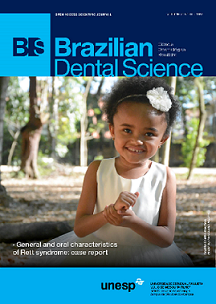Determination of chemical elements and cross-section hardness of sclerotic darkened human dentin
DOI:
https://doi.org/10.14295/bds.2017.v20i3.1412Abstract
Objective: The aim of this study was to assess the amount of chemical elements (Ca, O, C, P, Fe, and Mg) and the cross-section hardness of sclerotic darkened dentin in human teeth. Material and Methods: The study was approved by the local IRB and ten extracted teeth (five sound and five presenting sclerotic darkened dentin) were used. Tooth was sectioned mesiodistally and each half was used for each test. Amount of chemical elements (%w) was determined by energy dispersive X-ray spectroscopy (EDS) in three different dentin areas (shallow, medium, or deep sound or sclerotic dentin). Knoop microhardness was determined at the same EDS areas. Data were analyzed by two-way ANOVA and multiple comparison tests, with significance level at 5%. Results: No difference on microhardness was detected between sound and sclerotic dentin (p = 0.743) and also among dentin depths (p = 0.837). Lower Ca (p = 0.024) and higher C (p = 0.015) amounts were found at superficial sclerotic dentin. Increased Mg content (p < 0.001) was detected in sound dentin. Conclusion: It was concluded darkened sclerotic dentin presents similar cross-section microhardness to sound dentin. The assessed chemical elements were similarly present in sound or sclerotic dentin, except for Mg, which was present higher concentration in sound dentin. Ca and P were lower in superficial sclerotic dentin.
Keywords: Dentin; Hardness; Minerals; Tooth Remineralization.
Downloads
Downloads
Published
How to Cite
Issue
Section
License
Brazilian Dental Science uses the Creative Commons (CC-BY 4.0) license, thus preserving the integrity of articles in an open access environment. The journal allows the author to retain publishing rights without restrictions.
=================




























